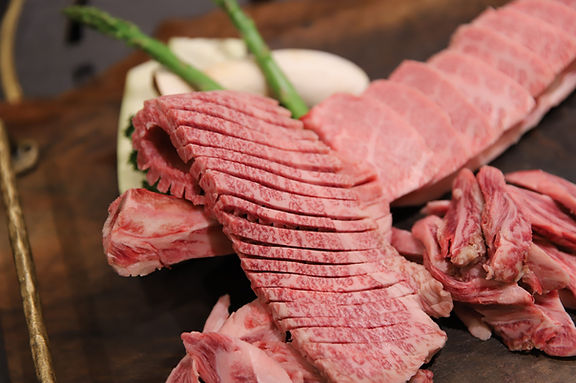Signature Menu
Spring 2024

Menu Description
Seolmyeong Samyo
Indulge in our signature "Seolmyeong Samyo" - a luxurious soup crafted from premium ingredients like abalone and dried sea cucumber, nestled in the velvety richness of seolleongtang. Seolleongtang, a traditional Korean beef bone broth simmered for hours, delivers a creamy, nourishing base, especially cherished during chilly seasons. Our rendition of Seolmyeong Samyo elevates this tradition, infusing dried sea cucumber and abalone into a slow-cooked Korean beef seolleongtang, simmered to perfection over 14 hours.
Four Welcoming Delights
a. Spring Salad: A vibrant medley of spring vegetables atop a bed of hotkigai, bringing forth the essence of the season.
b. Wolgwachae: A contemporary twist on Korea's esteemed royal cuisine, Wolgwachae. Tender vegetables and fresh Jeju hairtail fries encased in zucchini, accompanied by a zesty mustard sauce.
c. Boiled Octopus: Braised octopus drizzled with sweet pumpkin sauce, served atop a crispy buckwheat tart for a delightful contrast of textures.
d. Fish Mandu: Delight in our Fish Mandu - Eomandu, a regal Korean court delicacy dating back to the Goryeo Dynasty. Thin slices of seasonal fish enveloped in dumplings, enriched with brewed beef rib broth and spinach meringue.
Korean Pairing: Punjeongsagye, Chun
Let's start with the first pairing, 'Punjeongsagye, Chun,' a yagju which translates to 'Four Seasons, Spring' in Korean. Its crystal-clear appearance, refreshing acidity, and delicate mouthfeel complement our Four Delights, crafted with seasonal ingredients.
Yukhoe: Korean Seasoned Raw Beef
Experience the exquisite flavors of yukhoe, a tantalizing fusion of Korean beef tartare and the beloved worldwide snack, gimbap. Our yukhoe boasts a cool, garlicky, nutty profile with a hint of sweetness, highlighting the natural meatiness of the beef. Prepared in long slices and seasoned to perfection, it features a filling of white kimchi, creamy avocado, and light barley rice for a delightful textural contrast.
Mul-Kimchi and Jangajji
Mul-Kimchi literally means water-kimchi, since mul means water in Koren, It is made with Korean radish and cabbage, and often prepared in early winter using radishes and cabbages harvested in fall. Apparently, these vegetables are more plump and sweeter. Koreans preserve this during the winter and spring, and enjoy this during the whole seasons.
We also prepared 8 kinds of differnt Jangajjis - Korea has a wide variety of pickles. Some are pickled in soy sauce, and some are pickled in doenjang (Korean fermented soybean paste) or gochujang (Korean red chili pepper paste). In the old days, the salt content for pickling was very high for a long shelf life. With the invention of refrigeration and availability of vegetables all year round, that’s no longer necessary. We now simply enjoy pickles for their appetizing savory taste.
Grilled Korean Beef Parts
Indulge in a selection of grilled Korean beef parts, showcasing the savory allure and tender texture of Hanwoo beef. From the pristine tenderness of tenderloin to the robust flavor of traditionally marinated ribs, each cut offers a unique culinary experience. Hanwoo beef, renowned for its balance of meatiness and flavor, is a true delight reminiscent of wagyu but with a lighter, less greasy profile. Savor the clean taste of tenderloin, relish the original texture of rump, and delight in the signature flavor of Byeokje galbi ribs. You can exploere the rich, meaty aromas of unique cuts such as Hanger Steak, complemented by the earthy notes of Neungi mushroom sauce. Savor the prized tenderness of sirloin, enhanced by the bold flavors of red pepper sauce, adding a playful touch to each bite.
Korean Pairing: Geumsan Insamju
Geumsan Insamju (Mt. Geumsan Ginseng Soju) by artisan Changsoo Kim. This selection isn't just about enhancing flavors; it symbolizes wishes for robust health after the chill of winter. With its array of herbal notes and a clean finish, guests can savor their meal even more. After all, no visit to Korea is complete without a glass of soju, right?
Silver Pomfret (Butterfish) Jorim
Jeju Island produces one of the most beloved regional foods – silver pompret (deokja byeong-eo). This spicy and sweet Silver Pomfret Jorim is often called as bap-dodook (#밥도둑), or “rice thief” – a tasty food that compels you to eat a lot more rice than usual.
Korean Pairing: Heeyangsan Mountain Makgeoli
The sweetness and rich texture of Tagju, also known as Makgeoli, harmonize perfectly with the simmered red chili paste sauce of our braised silver pomfret. Heeyangsan Mountain Makgeoli perfectly fits the bill. Notably, the label of this Makgeoli features a tiger, emblematic of Korean folklore, as depicted by Mihwa Jeon, a renowned Korean fairytale writer.
Marinated Galbi and Pyeongyang Naengmyeon
With over 40 years of tradition, Byeokje Galbi presents a signature pairing of marinated galbi and Pyeongyang naengmyeon. Our Pyongyang cold noodles feature light buckwheat noodles bathed in a clear yet robust Korean beef broth. Enjoy a culinary delight as you savor the noodles alongside seasoned charcoal ribs, infused with soy sauce, sugar, garlic, and sesame oil for a symphony of flavors.
Traditional Desserts
Indulge in the sweetness of Tangerine Jeonggwa from Jeju Island and Kkwabaegi, the beloved Korean twisted donut. Tangerine Jeonggwa, a candied jelly infused with the essence of tangerines, offers a delightful burst of citrus flavor. Meanwhile, Kkwabaegi delights with its golden-brown, spiral-shaped dough. Accompanying this sweet feast is Lily Turf Tea, a medicinal brew cherished for its ability to invigorate and refresh during seasonal transitions. cherished for its ability to invigorate and refresh during seasonal transitions.